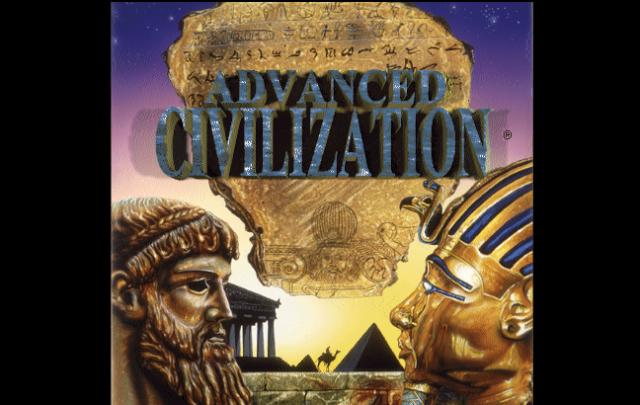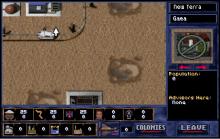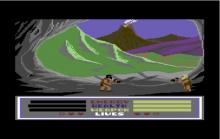Advanced Civilization
Press Keyboard right side: Alt+Enter keys to switch to full screen game play, and Alt+Enter keys to return.
How to play Advanced Civilization
Each game uses different controls, most DOS games use the keyboard arrows. Some will use the mouse.
Advanced Civilization Description
Avalon Hill's Advanced Civilization is a computer edition of the Civilization board game that includes the original game and the expansion to that game called Advanced Civilization.
It was published in 1995, shortly before Avalon Hill was bought out by Hasbro in 1998. It is now listed as abandonware and can be downloaded for free at Abandonia.
This game came out about the same time that Sid Meier's Civilization II was released and did not do as well in the market.
Both the board and computer game portray the same basic concept: the players manage ancient Mediterranean civilizations in an effort to move them from the Early Bronze Age to beyond the Iron Age. The game itself is a complex and ingenious combination of strategy, empire management, negotiation, and trading.
Game play and strategy
The game play involves a map of the Mediterranean Sea and surrounding lands, where each player controls one civilization chosen from a set of nine: Africa (dark brown), Asia (light orange), Assyria (turquoise), Babylon (light blue), Crete (light green), Egypt (light brown), Illyria (yellow), Italy (pink, also named Iberia) and Thrace (dark green). Players move population units across the board, taking over territory and competing with your opponents for the most sought after land. Well thought-out movement can allow your units to drive other players off certain land, or allow you to place your units strategically for a future foray.
A game of Advanced Civilization typically takes at least 6 hours, and can take up to 18 hours with a full 8 players, especially if some are unfamiliar with the game, or given to deep strategic analysis each turn. Players progress together through the phases of each turn. Under normal conditions the game is highly interactive, with little downtime spent waiting for other players to decide what to do. Useful aids to play, such as spreadsheets for calculating the costs of purchase of tools given discounts from other tools, have been devised by players.
Once your population reaches a sufficient size, you can congregate the units into cities. These cities can later be attacked for valuable plunder and to deal a blow to your opponents' chances of winning. To play well, you must move your population in order to expand efficiently into cities and defend your cities from attack, especially during their most vulnerable time: the turn in which they are built. However Advanced Civilization is not a wargame, and aggression must be pursued very carefully. Overly aggressive play has a strong tendency to hold back the progress of both aggressor and victim, as compared to the uninvolved players. The primary source of damage to players' civilizations comes from calamities rather than warfare. Calamities are somewhat under players' control, and can be managed by purchase of appropriate tools.
Building cities is very important, as they allow your civilization to produce commodities such as iron, salt, wine, bronze, or spices. For each city you have, you may draw a card from a commodity card deck, numbered 1 (ochre and hides) through to 9 (gold and ivory). Cards are drawn in ascending order, ie those who have the least cities draw cards first. The more commodities your civilization produces, the more valuable the types of commodities that you can produce. Hidden within each commodity deck are also one or two calamities, such as earthquake, famine, barbarian hordes, or civil war, each of which seriously damage your population and destroy your cities. Such is the risk of collecting valuable commodities. All commodity and calamity cards have identical backs, for trading face-down. Some calamities, generally the worse ones, are not tradeable. Most tradeable calamities have consequences to other players (for example, epidemic allows the sufferer to distribute secondary losses among opponents), and generally the player who traded the calamity is exempt from being chosen.
Once your civilization accumulates enough commodites, you can trade them with your opponents in order to corner the market on a particular commodity and increase its value. By creating sets of two or more of the same commodity (e.g. 4 units of salt) the value of the commodity increases as a second degree polynomial. To trade, you offer your opponents three of your commodity cards in exchange for three of theirs. You must tell your trading partner (publicly, so other opponents may hear) truthfully what two of the three are, and you may declare the third truthfully or not as you please; it is the "bluff". The bluff can be a low-value commodity, or you can trick your opponent into taking a calamity off your hands. Of course, that 'silver' your opponent offers you just might be the feared epidemic, and you have to weigh the potential gains and losses before accepting.
Once you collect enough commodities, your civilization spends them to purchase tools, also known as advances, which range from pottery or astronomy to democracy or monotheism. By acquiring these tools, players' civilizations gain victory points, and these tools also give each civilization particular advantages during the game play, many providing the ability to mitigate calamities. For example, engineering makes your cities stronger from enemy attack, gives you an advantage in attacking other cities, and makes you less vulnerable to flood. Tools are divided into categories such as Science, Craft, Civics, etc. Purchasing a tool of one category normally entitles you to a discount to further purchases in that category, and often also entitles you to a discount to the purchase of specific tools. Some tools have prerequisites for purchase.
By collecting useful tools and maintaining as many cities as possible on the board, your civilization advances through the ages. At the end of each turn, civilizations with enough cities and enough tools in appropriate categories are allowed to advance along the game's turn track, the Archaeological Succession Table (AST). Different civilizations have slightly different entry requirements to the spaces on the AST, which balances positional advantages on the board. A civilization unfortunate enough to end the turn with no cities at all will go backwards on the AST. Once one or more players have reached the end of the AST, the game ends and the winner is decided based on a calculation of victory points. The majority of victory points come from purchase of tools and progress along the AST. Cities and stock at the end of the game provide a minor boost to victory points, sometimes sufficient to decide a close-fought game.

















